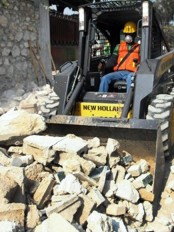|
||||||||||||||||||
|
|
Haiti - Reconstruction : (II) Debris removal and management - Strategic Plan 05/01/2011 08:23:10
While donors begin to fulfill their pledges and have difficulty accessing the facts about what is needed most on the ground, many are asking how to prioritize their spending. The strategic plan presented at the fourth meeting of the IHRC, December 14, 2010 at Santo Domingo in the Dominican Republic, will help guide the project implementers, donors and investors as they guide the disbursement of their pledges for the reconstruction and development of Haiti, and add much needed new funding. Developed jointly by the Commission, international experts and ministry leaders, this plan outlines many of the most important things needed in Haiti by October 2011, the end of IHRC’s mandate. Each day of the week we'll discover a part of this strategic plan for 2011. Today we cover the debris removal and management. Debris removal is key to most development and recovery priorities. Very little debris has been removed – few neighborhoods are mostly clear of debris – and there are few organizations that are removing debris on a large scale. Furthermore, existing work is being carried out without the guidance of an overall framework. Debris removal has been slow to start in part because key policy decisions have not been made – for instance not all buildings categorized as being beyond repair can yet be demolished. Further, there is no reliable tracking mechanism in place to adequately monitor progress and there is not yet a full assessment of how much debris exists, making planning difficult. A challenge of this complexity and magnitude demands an overall strategy. The strategy should recognize multiple debris removal methods based on their effectiveness given the particularities and constraints of each geographical area rather than a blanket strategy for the whole country. It is also vital that a global strategy address how debris will be disposed and possibly recycled. The current uncontrolled dumping that is the norm for many sites may cause future issues. The environmental impact of rubble disposal has been studied and the rubble is an inert material that poses little significant risk, with source separation of municipal & other waste streams. The plan also needs to address disposal site management, including best practices for site operation, enforcement mechanisms and creating income generation opportunities through debris recycling where possible & practical. To date, there have been several estimates of the amount of debris generated by the earthquake. For the purpose of this document, it is assumed that there is a volume of 10 million cubic meters of remaining debris to be removed. The IHRC has created an approach targeted to remove 40% of debris by the end of its mandate. Now is the time for immediate action. The international community must come together to execute the plan. Debris removal efforts under way There are many fragmented debris removal efforts underway. Supplementing the continuous effort of the Government of Haiti (GOH) on debris removal, various NGOs, bi-lateral and multilateral actors have implemented debris removal projects on specific streets and /or facilities. A proper strategic implementation led by the Government of Haiti requiring all organizations removing debris to provide periodic reports on progress made is needed to create a global view of all on-going efforts. Recycling Separating the rubble from waste is currently conducted, for the most part when it occurs, on the collapsed or demolished structure site by hand. The rubble is commonly reused in a number of ways:
This use of the rubble may be utilizing an unskilled Haitian work force and can be a source of income to otherwise unemployed citizens, in addition to minimizing final disposal of reusable material. An advantage of this recycling alternative is that it relieves the demand on construction material that will be necessary to repair and reconstruct the large number of affected structures. The process, however, can be time consuming and the rubble has to be stored relatively close to the site where it will be used. It is also worth noting that sustainable practices and cultural acceptance are of concern. Several studies have been done and are continuing regarding the use of processed rubble as aggregate in concrete mix, for low strength concrete. Most studies so far are recommending further studies before committing to the adequacy of such use. Debris removal strategies There are several approaches each with their respective set of advantages and disadvantages:
The time and cost to implement these strategies is different:
The IHRC recommends a Systematic Neighborhood Approach: it would combine both the neighborhood and the US Army approaches to ensure that entire earthquake affected areas are addressed without overlooking certain neighborhoods. In order to achieve this, the GOH will need to work closely and track the various organizations’ work on debris removal and develop a plan to compensate areas not currently addressed and/or incite additional interest from others capable of implementing debris removal projects. This plan will have the advantage of working within areas under the jurisdiction of local authorities, for more effective coordination between all parties. In addition, a number of efforts already in progress can continue while additional resources are sought to complement them. This approach may also have significant costs savings potential with multiple disposal sites and strategic implementation. Target By October 2011, 40% of all debris, representing 4 million cubic meters will be removed Rationale Despite its higher cost, the systemic neighborhood approach is preferred over other approaches as it ensures debris removal in a relatively time efficient manner. This is essential for the recovery of Haiti for three primary reasons. First, the safety & health of the people in Haiti. Secondly, the removal of debris is a clear prerequisite for other development priorities such as housing, hospital and school construction. Thirdly, the removal of debris will serve as a very visible manifestation of development improvements. Required programs To reach this target will require a debris removal operation characterized as follows
These operations shall be distributed into various projects / contracts, but it is essential that they be supported by a central coordinating unit, ideally under the MTPTC and monitored to international standards for transparency Funding requirement Using the systemic neighborhood approach, an average cost of $40 per cubic meter is estimated. To remove 4 million cubic meters by October 2011 (40% of 10 million cubic meters total debris), would therefore cost $160 million. The remaining 60% of debris would have a cost of $240 million, making for a total cost of $400 million, with significant cost saving potential through strategic goals and management thereof Policy decisions and institutional enablers Three things are particularly important to enable the execution of this debris removal program:
The IHRC is ready and able to support the Government in developing these solutions. Interdependencies with other sectors The removal of debris is a key requirement for ensuring progress in other development areas requiring construction. The selection of sites for debris removal must therefore be seen in connection with other development plans. This coordination can be enabled using detailed mapping, allowing for the assignment of priority sectors for debris removal. See also: https://www.haitilibre.com/en/news-2033-haiti-reconstruction-i-housing-strategic-plan.html https://www.haitilibre.com/en/news-2047-haiti-reconstruction-iii-education-strategic-plan.html https://www.haitilibre.com/en/news-2054-haiti-reconstruction-iv-health-strategic-plan.html https://www.haitilibre.com/en/news-2062-haiti-reconstruction-v-energy-strategic-plan.html https://www.haitilibre.com/en/news-2066-haiti-reconstruction-vi-job-creation-strategic-plan.html https://www.haitilibre.com/en/news-2073-haiti-reconstruction-vii-water-and-sanitation-strategic-plan.html https://www.haitilibre.com/en/news-2082-haiti-reconstruction-viii-reinforcement-of-institutions-strategic-plan.html HL/ S/ HaitiLibre /CIRH
|
|
|
Why HaitiLibre ? |
Contact us |
Français
Copyright © 2010 - 2024 Haitilibre.com |



